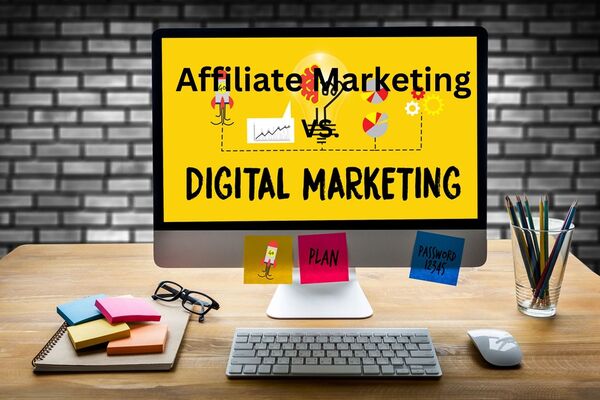In today’s interconnected world, digital marketing is a powerful way to promote products and services, and affiliate marketing is a key part of that larger ecosystem. However, while both fall under the broader umbrella of online marketing, they differ significantly in strategies, execution, and goals. In this article, we will explore the differences between affiliate marketing and digital marketing, the advantages of each, and how they complement each other in the ever-evolving world of online commerce.

1. Defining Digital Marketing and Affiliate Marketing
What is Digital Marketing?
Digital marketing is a broad term that encompasses all marketing efforts that use the internet or an electronic device. It includes strategies such as search engine optimization (SEO), pay-per-click (PPC) advertising, content marketing, social media marketing, email marketing, and more. The goal of digital marketing is to connect businesses with potential customers online, building brand awareness and driving traffic, leads, and sales.
What is Affiliate Marketing?
Affiliate marketing is a subset of digital marketing that involves performance-based partnerships. In this model, a company rewards affiliates (individuals or other businesses) for driving traffic, leads, or sales through their marketing efforts. Affiliates typically promote products or services using blogs, social media, email marketing, or their own websites, and they earn a commission on every successful sale or lead.
2. The Scope of Digital Marketing vs. Affiliate Marketing
Digital Marketing: A Broad Spectrum
Digital marketing covers an extensive range of strategies and platforms, aiming to attract and engage users at various stages of their buyer’s journey. Marketers use multiple channels to capture attention, from search engines like Google to social media platforms like Facebook, Instagram, and LinkedIn. Here are some key areas of digital marketing:
- SEO (Search Engine Optimization): The practice of optimizing content to rank higher in search engine results.
- PPC (Pay-Per-Click Advertising): Paid advertising that generates traffic by charging advertisers each time their ad is clicked.
- Content Marketing: The creation and sharing of valuable content to attract and retain a target audience.
- Email Marketing: Sending targeted messages to individuals to nurture leads and build customer relationships.
- Social Media Marketing: Promoting content, services, or products on social media platforms to engage users and increase brand visibility.
Affiliate Marketing: A Niche Strategy
Affiliate marketing, on the other hand, is a more focused, performance-driven model. Affiliates use digital marketing tactics to promote products or services, but their ultimate goal is to drive conversions (sales, leads, or actions) rather than just increasing visibility. Unlike traditional digital marketing campaigns that may prioritize brand awareness, affiliate marketing directly ties promotion efforts to measurable results.
In affiliate marketing, affiliates may use several digital marketing strategies, including:
- Content Creation: Writing product reviews, tutorials, or creating videos to promote affiliate products.
- Email Marketing: Sending offers or promotions to their audience to generate affiliate sales.
- Social Media: Using platforms like Instagram or YouTube to share affiliate links and drive conversions.
3. The Financial Models of Digital Marketing vs. Affiliate Marketing
How Digital Marketing is Funded
In most digital marketing strategies, businesses directly fund campaigns through advertising spend or investment in content creation. Whether running a PPC campaign or producing content, businesses typically have upfront costs that are aimed at driving long-term value, such as leads or brand awareness. Common digital marketing financial models include:
- Pay-Per-Click (PPC): Advertisers pay for each click their ads receive.
- Cost-Per-Thousand Impressions (CPM): Businesses pay based on the number of times their ad is displayed.
- Cost-Per-Acquisition (CPA): Businesses pay when specific actions (like sales or lead generation) are completed.
How Affiliate Marketing Earns Revenue
Affiliate marketing is a low-risk, commission-based model for businesses. Affiliates bear the responsibility for driving traffic, and businesses only pay when the desired result (a sale or lead) is achieved. This performance-based model means affiliates earn money for each successful conversion they generate, making it a more cost-effective strategy for companies.
- Commission-Based: Affiliates are paid a percentage of the sale price for each product or service sold.
- Pay-Per-Lead (PPL): Affiliates are paid a fixed fee when they generate leads, such as email sign-ups or free trial registrations.
4. Benefits of Affiliate Marketing vs. Digital Marketing
Advantages of Digital Marketing
- Wide Reach: Digital marketing gives businesses the opportunity to reach a global audience through multiple channels.
- Data-Driven: With digital marketing, companies have access to rich data, allowing them to optimize campaigns for better performance.
- Multi-Channel Engagement: Businesses can engage with their audience on a variety of platforms, including search engines, social media, and email.
- Brand Building: Digital marketing is ideal for increasing brand visibility, trust, and loyalty over time.
Advantages of Affiliate Marketing
- Performance-Based: Businesses only pay for measurable results, making affiliate marketing a low-risk, high-reward strategy.
- Niche Focus: Affiliates often have specialized knowledge or audiences, enabling businesses to target highly specific market segments.
- Cost-Effective: Since businesses pay only for completed sales or leads, affiliate marketing is a budget-friendly way to scale sales.
- Passive Income for Affiliates: Affiliates can generate passive income by promoting products or services without needing to handle inventory or customer service.
5. Combining Affiliate Marketing with Digital Marketing
Both affiliate marketing and digital marketing have their own unique strengths, and when combined, they can create a powerful strategy for growth. Digital marketing channels, such as SEO and content marketing, can be used by affiliates to drive traffic to affiliate links, while businesses can use traditional digital marketing campaigns to complement their affiliate efforts.
For example:
- SEO can boost the visibility of affiliate content, driving more organic traffic to affiliate links.
- Email Marketing can nurture potential buyers and increase conversions through personalized affiliate offers.
- Social Media can amplify affiliate promotions through influencer partnerships and paid ads.
6. Challenges in Affiliate Marketing and Digital Marketing
Challenges in Digital Marketing
- Increasing Costs: Running PPC campaigns or creating high-quality content can become costly, especially in competitive industries.
- Constant Algorithm Changes: Search engines and social media platforms frequently update their algorithms, making it difficult to maintain rankings or visibility.
- Complex Data: Analyzing and optimizing large amounts of data from different channels can be overwhelming.
Challenges in Affiliate Marketing
- Finding the Right Affiliates: Not every affiliate is a good fit for every business. Finding reliable, trustworthy affiliates can be a challenge.
- Managing Compliance: Affiliates must comply with legal requirements, such as FTC disclosure guidelines, which can be complex and vary by region.
- Tracking and Attribution: Accurately tracking sales or leads generated by affiliates can be difficult, especially in multi-channel campaigns.
7. Conclusion
While affiliate marketing and digital marketing share common goals—such as driving traffic, sales, and brand awareness—they differ significantly in scope, strategies, and financial models. Digital marketing is a broad, comprehensive approach that spans multiple online channels, while affiliate marketing focuses on performance-driven partnerships. Both have their unique advantages and challenges, and businesses can achieve the best results by using them in tandem.
For businesses, understanding how to integrate affiliate marketing into a wider digital marketing strategy can lead to a more efficient, cost-effective approach to growth. For affiliates, leveraging digital marketing strategies can enhance their ability to drive conversions and earn commissions.
By harnessing the strengths of both affiliate and digital marketing, businesses and marketers alike can maximize their success in the ever-evolving world of online commerce.

